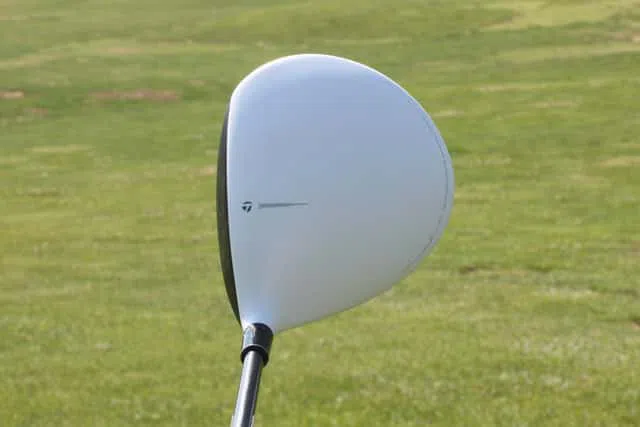TaylorMade R15 Driver Review

There is no doubting that the TaylorMade R series of drivers is among the most popular in the world. Perhaps the top brand in golf, TaylorMade has forged a reputation for quality products catering for all from the novice to the experienced professional.
A driver is very much a personal choice. It’s one club that you will form a relationship with, and finding the right one may not be the work of a moment. Is the TaylorMade R15 driver for you?
In this review, we will tell you all about the specifications and characteristics of the TaylorMade R15, and give you our verdict as to its prowess and potential, so let’s not hang about, meet the TaylorMade R15 driver!
Contents
The Key Features
Before we get into detail, let’s bullet-point a few key features of the TaylorMade R15:
- 460cc head
- Low to forward center of gravity for low spin
- Sliding split weights for personalised feel
- Fujikura Speeder 57 Evolution shaft
- Lamkin UTX grip
- Front track system designed to reduce spin and enlarge sweet spot
So, briefly from the above we can conclude that this is a driver designed for user-friendliness. Now, let’s go through its specification in more detail.
Center of Gravity
We’ll begin by talking about the center of gravity which, as the above brief spec says, is low to forward for the TaylorMade R15. What does this mean, what is it all about, and why is center of gravity (CG) so important?
The balance of your driver will be affected by the CG. It also affects, quite dramatically in some cases, the way the ball flies. Have a look at this:
Front CG will produce less back spin, back CG will produce more;
Left CG will produce more draw spin, right CG the opposite.
High CG means more back spin, low CG the opposite.
Does that give you an idea of the concept? Basically, a player can choose a club to help with their traits, and it follows that a club with CG towards the front is generally preferred.
The TaylorMade R15 features low-forward CG, closer to the heel. What does this mean for the player?
Put simply, the TaylorMade R15 is designed to reduce spin, and therefore to increase the distance, to provide a better trajectory and to improve penetration. In theory, these are all the aspects you need in a driver, so we’re on point here.
Sliding Split Weight
One of the more interesting and innovative features of the TaylorMade R15 is the use of sliding split weights. This has been incorporated to improve the handling of the club in terms of precision, which can be affected by the choice of low-front CG, as explained above.
The TaylorMade R15 features a pair of fully moveable 12.5g weights that can be slid to the position you want for the result you require. They even provide the tool for loosening and tightening them. The benefit of this is that you can genuinely tailor the weight distribution for your own personal taste. Here’s how it works:
- Both weights in the middle: this will give you, for want of a better word, more clout. Your strike will be solid and powerful and, as long as you get the swing speed right, you will find that you can achieve impressive distance in this configuration.
- Both weights to the heel: the result of putting the pair of weights to heel is that you will notice straight shots becoming more of a draw; not dramatically, but enough to make a difference. Naturally, move the weights to the other side, and you will see more fade.
- One at each end: the result of splitting the weights apart is greater forgiveness and stability.

We could go on and list another 18 settings, as there are no fewer than 21 different positions that the two weights can be set at. This is a great innovation by TaylorMade, and one that helps the player to find a center of gravity that is to their own taste and suitability.
Front Track System
One of the reasons why TaylorMade has become such a highly regarded brand in golfing circles is its dedication to innovation. The TaylorMade R15 may not be its top-flight driver – that would be the M-series drivers – but it does not lack in terms of innovative features, the Front Track System being one such.
The front track has been moved 12mm closer to the front edge than on the club this one replaces, the SLDR, and the addition of an extra weight as seen above – that club only had one – means it is more versatile in every way.
This change in center of gravity means better speed and, as a result, greater distance, benefits that are very strong in all areas of the TaylorMade R15.
The Shaft
By using the Fujikura Speedster 57g shaft – which also appeared on the SLDR – TaylorMade is utilising a top quality shaft that reaches a decent length of 45.5inches – not too long, and not too short.
Very light and yet strong, this is regarded as one of the best – if not the best – shafts in the business, and it is no surprise TaylorMade continues with it.
The Grip
Once again, TaylorMade chooses to go with the market leaders in using the Lamkin UTx grip for the R15, and this is regarded as an all-weather grip par-excellence. With a perfect combination of comfort, grip and shock absorption, they could not have made a better choice.
So, to summarise, the TaylorMade R15 features innovative sliding weights and an improved front track system, has ideal center of gravity – that is adjustable – and comes with the best shaft and grip in the business. What’s not to like?
We’re about to give you our review of the TaylorMade R15 from our perspective, having explained the specifications above, so let’s start by jumping ahead a little, and giving you a quick run-down of the pros and cons.
The TaylorMade R15: Our Review
We had a good look at the TaylorMade R15 and came to a few conclusions, so to put you in the picture, here are what we believe are the pros and cons of this quality driver:
Pros
- Feel – we found the overall feel of the TaylorMade R15 to be very good indeed, it’s easy to handle and one of the best.
- Looks – if you’re concerned what your driver looks like, this is a very good looking club!
- Distance – absolutely top of the game in this respect, the design and innovation pays off
- Accuracy – those moveable weights make things very forgiving, it’s an easy club to play with
Cons
- Not for novices – this is too complex a club for the novice, and is aimed at single-figure handicap players
- Difficult to curve – because of the general design and CG characteristics, curving the ball can be difficult with the TaylorMade R15.
So, now you’ve had a brief look at those, let’s get into a bit more detail about the TaylorMade R15.

Innovation and Technology
The TaylorMade R15 is, as we have already mentioned, brimming with very clever technological advances that are entirely typical of this brand. The sliding weight system is the main talking point, and brings with it many benefits. Let’s just recap on how those weights affect the performance of the club, depending upon where you lock them into place.
Remember we said there were 21 possible combinations? We’re not going to give you them all, but the basics may be useful, and are as follows:
For maximum distance, both weights in the middle;
For maximum draw, both weights towards the heel;
For maximum fade, both towards the toe;
For maximum stability, set the weights as far apart as they can go.
Clearly, you can play around with the weights and achieve a setting that is right for you, and it’s a feature of the TaylorMade R15 that we are impressed by.
Further technological advances include the Ultra-Thin Casting, which is designed to save weight – to the tune of 4 grams. This will affect the performance when compared to other clubs. Also, the club uses an advanced version of the TaylorMade Inverted Cone Technology in the head, which is designed to increase the sweet spot, and this is certainly another welcome development.
Playability and Feel
One of the areas in which the TaylorMade R15 shows great improvement over its predecessor, the SLDR, is in the overall forgiveness, ease of use and playability it provides. With the sliding weights increased to two you can find the ideal balance more easily, and the larger sweet spot means fewer mishits and greater accuracy.
Being able to tailor the weights as we explained above means that you can reach a personalised level of performance with this club, and the top quality shaft and grip are also welcome additions to what is a top-quality club.
The great thing about the adjustable areas is that you also fine-tune the feel of the club. Of course, this means that it may feel great to you but, should another player try your settings, it may feel awkward to them! Overall, a very easy to play with, great feeling club that you can balance as you wish.
Performance
We’ll keep this brief: the TaylorMade R15 performance superbly in most areas. Bear in mind you can choose from a variety of loft angles – something that some players still believe to be a simple gimmick – so when it comes to the personalisation we speak of above, you can take things to an even greater degree of perfection.
Compared to its predecessor, distance, trajectory and penetration are all improved, and it’s down in no small part to the clever innovation and those very neat moveable weights.
This is a well-made, top quality, good looking club that you can use on your round or equally on the driving range. In fact, for the latter, the TaylorMade R15 might be the perfect club to practice with. The bigger sweet spot, great balance and fine-tuning ability mean you could achieve 300-yard hits realistically, and that’s going some, even for a club of this level.
PGA Pro Rick Shiels has done an in-depth review on the R15 driver, check it out below or watch it on YouTube here.
Our Conclusion
We looked carefully at all aspects of the TaylorMade R15 in order to get a feel for it in every way. We tried not to compare it to the M-series – that would be unfair as it is priced at roughly $200 less than those models – and instead had a look at it alongside some similarly priced competition.
Against the Titleist 915 D2, which is perhaps the closest competitor in price, the TaylorMade R15 scored very highly in terms of distance and precision, though the Titleist is more forgiving. That may not be the case if a particular player has spent time with the moveable weights and found their ideal setting.
We also had to compare it to the Callaway Big Bertha Alpha 815 and the results were interesting. In fact, there’s little between them, but for many golfers the adjustable weights may sway them towards the TaylorMade R15.
Of course, there will be many players for whom brand loyalty is already established. If you’re a Callaway man – or woman – then you’re likely to remain one! If, however, you are a TaylorMade player, then we reckon the TaylorMade R15 is an excellent replacement for the good but flawed SLDR that went before it, with improved features all-round, and easily among the best clubs of its type and class on the market today.




